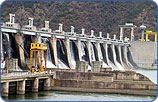 |
Hydraulic works in the form of dams and reservoirs are found in all mountainous areas of the Danube basin, while most navigation canals, dyke and irrigation networks concentrate on the lowlands along the central and lower Danube. The building of large dike systems for flood protection started in the 16th century in Hungary. Old networks of drainage/irrigation systems exist in all basins, for instance in the Banat (northern YU) and in southern Romania. The first major Danube regulation works started in 1830 in Upper Austria; the first Danube hydro dam was built in 1927 at Vilshofen (lower Bavaria). Today, hydro-power utilisation and energy production varies substantially from country to country, e.g.
50.9% of all rivers (catchment > 500 km²) are impacted by hydropower (impounded, residual flow, or peak operation). The totally installed hydropower capacity in the Danube basin is in the order of 29,200 MW. The biggest hydropower dam and reservoir system along the entire Danube is located at the Djerdap (Iron Gate) gorge (117 km long). It is a peak operation system with two dams, jointly operated by Romania and Serbia & Montenegro (average Danube flow: 5,500 m³/sec, overall drop: 34 m; installed capacity: 1,266 MW, annual production: 6,490 GWh. The Iron Gate system has transboundary effects. The reservoirs (volume 3.2 billion m³; length: 270 km) catch some 20 million tons of sediments per year, thus serving both as an important nutrient sink and a deposit of hazardous and toxic matter for pollution originating in the upstream Danube catchment. At the same time, sediments are missing downstream and have created erosion problems since the dam was put into operation in 1970. The second largest dam system is Gabcikovo near Bratislava, in operation since 1992. It is located near one of the once-largest Danube wetlands. Today, 8,000 ha of floodplain forests and a network of side-arms are artificially irrigated: They are disconnected from the river which receives only 10-20% of its water; 80-90% are directed to the power plant, producing some 10% of Slovak electricity. A few more dams are planned to be built e.g. on the Bavarian Danube, on the Sava and on the Drava along the Croatian-Hungarian border, where the Novo Virje dam (planned capacity: 121 MW) would dissect the still largely pristine Mura-Drava river continuum of altogether 370 km between the Austrian border and the confluence with the Danube. |






